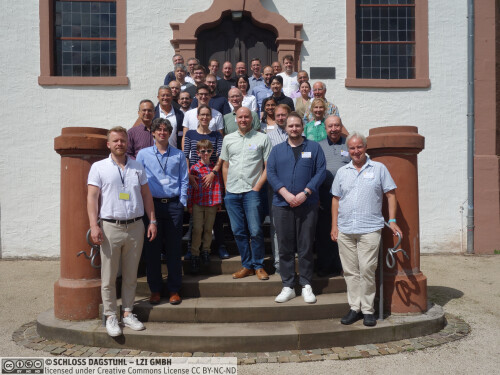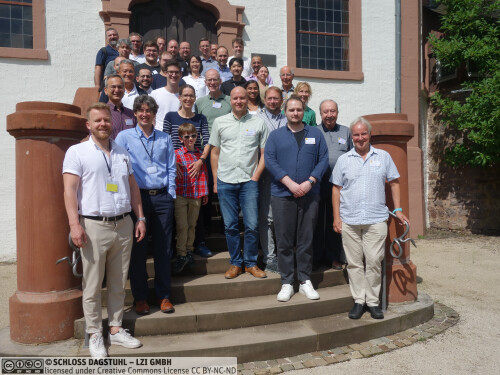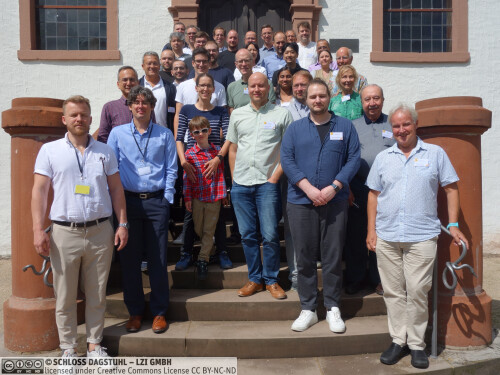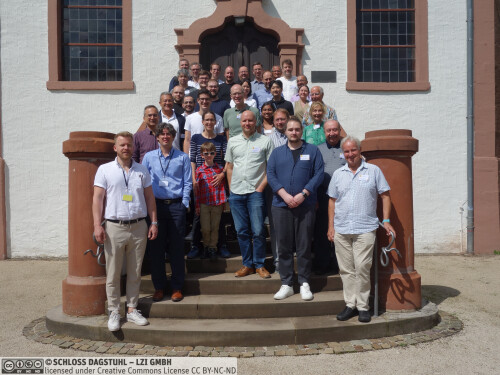Dagstuhl-Seminar 23331
Recent Trends in Graph Decomposition
( 13. Aug – 18. Aug, 2023 )
Permalink
Organisatoren
- Seher Acer (Google - Sunnyvale, US)
- George Karypis (University of Minnesota - Minneapolis, US)
- Christian Schulz (Universität Heidelberg, DE)
- Darren Strash (Hamilton College - Clinton, US)
Kontakt
- Marsha Kleinbauer (für wissenschaftliche Fragen)
- Simone Schilke (für administrative Fragen)
Impacts
- Buffered Streaming Edge Partitioning : article in 22nd International Symposium on Experimental Algorithms (SEA 2024) - Chhabra, Adil; Faraj, Marcelo Fonseca; Schulz, Christian -Heidelberg-; Seemaier, Daniel - Wadern : LZI, 2024. - pp. 5:1-5:21 - (Leibniz International Proceedings in Informatics : 301 : article).
- Scalable Multilevel and Memetic Signed Graph Clustering - Hausberger, Felix; Faraj, Marcelo Fonseca; Schulz, Christian - Cornell University : arXiv.org, 2024. - 14 pp..
- Open Problems in (Hyper)Graph Decomposition - Ajwani, Deepak; Bisseling, Rob H.; Casel, Katrin; Catalyurek, Umit V.; Chevalier, Cédric; Rosamond, Frances A.; Petrini, Fabrizio; Pellegrini, Francois; Mizutani, Yosuke; Meintrup, Johannes; Mayer, Ruben; Li, Xiaoye Sherry; Langguth, Johannes; Lacki, Jakub; Kaya, Kamer; Karypis, George; Heuer, Tobias; Gottesbüren, Lars; Fellows, Michael R.; Faraj, Marcelo Fonseca; Chudigiewitsch, Florian - Cornell University : arXiv.org, 2024. - 30 pp..
Programm
Large networks are useful in a wide range of applications. Sometimes problem instances are composed of billions of entities. Decomposing and analyzing these structures helps us gain new insights about our surroundings. Even if the final application concerns a different problem (such as traversal, finding paths, trees, and flows), decomposing large graphs is often an important subproblem for complexity reduction or parallelization. With even larger instances in applications such as scientific simulation, social networks, or road networks, graph decomposition becomes even more important, multifaceted, and challenging. The seminar was an international forum to discuss recent trends as well as to set new goals and new directions in this research area. The goal of this Dagstuhl Seminar was to bring algorithmic researchers from different communities together who implement, optimize, and/or experiment with algorithms running on large data sets or use techniques from the area frequently, thereby stimulating an exchange of ideas and techniques. The seminar focus was on graph decomposition. We chose the main topics of our seminar to bring experts together from a wide range of areas to tackle some of the most pressing open problems in the area of graph decomposition:
Hardware Design for Dealing with Graphs. Modern processors are optimized for computations that are floating point intensive and have regular memory accesses. Computations performed by sparse graph algorithms do not benefit from such optimizations. To address this mismatch, new processor and system architectures are being developed.
Beyond Smart Heuristics. In heuristic approaches, improvements in solution quality are often the result of a significant research effort. In recent years, to reduce this effort, develop better heuristics, and ultimately find better solutions, researchers have started developing approaches that use deep neural networks and reinforcement learning in order to learn those heuristics in an end-to-end fashion.
Formulations. Applications that process large sparse data generally have a unique set of optimization requirements for achieving the best performance. Parallelizing such applications on different architectures and/or using different frameworks introduces new performance issues that pertain to these architectures and frameworks. While graphs offer a rich ground for modeling such problems with different requirements, traditional graph decomposition tools may fall short to target those specific issues.
Scalable Parallel Algorithms for Future Emerging Architectures. Scalable high quality graph partitioning (with quality comparable to sequential partitioners) remains an open problem. With the advent of exascale machines with millions of processors and possibly billions of threads, the situation is further aggravated. Moreover, traditional “flat” partitions of graphs for processing on such machines implies a huge number of blocks. Efficient implementation is also a big issue since complex memory hierarchies and heterogeneity (e.g., GPUs or FPGAs) make the implementation complicated.
Summary of Seminar
The seminar convened 33 distinguished participants from both academic and industrial sectors worldwide. The majority of attendees arrived on Sunday evening. In total, the seminar showcased 19 presentations. The proceedings began with a welcome and ice-breaker session, facilitating introductions among participants. There were two dedicated sessions to address open problems. Ample time was set aside for collaboration. Additionally, a social event in the form of a hike was organized for attendees. The majority of the presentations were concise, spanning approximately 30 minutes, while a select few were of longer duration. Active discussions were a hallmark of this seminar, both during and after presentations, with highlights captured in the full report. Spontaneous working groups emerged during the event, and their details are documented in the full report. During the week, we collaborated on a joint document that captures a large variety of open problems in the field. These so-called community notes which will be released/published in a separate document. Throughout and following the sessions, participants engaged in lively conversations. These discussions enriched the entire event and set it apart from typical conference formats. Beyond the research-focused activities, numerous social events like board games, poker, music evenings, hiking, and ping pong added a fun dimension. This made the seminar an excellent networking venue, especially for the many attendees experiencing Schloss Dagstuhl for the first time.
 George Karypis, Christian Schulz, and Darren Strash
George Karypis, Christian Schulz, and Darren Strash
Large networks are useful in a wide range of applications. Sometimes problem instances are composed of billions of entities. Decomposing and analyzing these structures helps us gain new insights about our surroundings. Even if the final application concerns a different problem (such as traversal, finding paths, trees, and flows), decomposing large graphs is often an important subproblem for complexity reduction or parallelization. With even larger instances in applications such as scientific simulation, social networks, or road networks, graph decomposition becomes even more important, multifaceted, and challenging. The seminar is an international forum to discuss recent trends as well as to set new goals and new directions in this research area. The goal of this Dagstuhl Seminar is to bring algorithmic researchers from different communities together who implement, optimize, experiment with algorithms running on large data sets or use techniques from the area frequently, thereby stimulating an exchange of ideas and techniques. The seminar focus will be on graph decomposition. We chose the main topics of our seminar to bring experts together from a wide range of areas – areas that recently have been fruitful in a variety of applications – to tackle some of the most pressing open problems in the area of graph decomposition:
Hardware Design for Dealing with Graphs. Modern processors are optimized for computations that are floating point intensive and have regular memory accesses. Unfortunately, the computations performed by sparse graph algorithms do not benefit from such optimizations. To address this mismatch, new processor and system architectures are being developed. These architectures, exemplified by Intel’s newly announced PUMA architecture, combine highly parallel execution with a word-level accessible global addressable memory. Leveraging the potential of such architectures requires new classes of algorithms.
Beyond Smart Heuristics. In heuristic approaches, improvements in solution quality are often the result of a significant research effort. In recent years, to reduce this effort, develop better heuristics, and ultimately find better solutions, researchers have started developing approaches that use deep neural networks and reinforcement learning in order to learn those heuristics in an end-to-end fashion.
Formulations. Applications that process large sparse data generally have a unique set of optimization requirements for achieving the best performance. Parallelizing such applications on different architectures and/or using different frameworks introduces new performance issues that pertain to these architectures and frameworks. While graphs offer a rich ground for modeling such problems with different requirements, traditional graph decomposition tools may fall short to target those specific issues. This seminar will make more researchers aware of formulations that benefit from the existing state-of-the-art software and encourage them to propose new formulations tailored to their own specific applications.
Scalable Parallel Algorithms for Future Emerging Architectures. Scalable high quality graph partitioning (with quality comparable to sequential partitioners) remains an open problem. With the advent of exascale machines with millions of processors and possibly billions of threads, the situation is further aggravated. Moreover, traditional “flat” partitions of graphs for processing on such machines implies a huge number of blocks. Efficient implementation is also a big issue since complex memory hierarchies and heterogeneity (e.g., GPUs or FPGAs) make the implementation complicated.
 Seher Acer, George Karypis, Christian Schulz, and Darren Strash
Seher Acer, George Karypis, Christian Schulz, and Darren Strash
- Deepak Ajwani (University College Dublin, IE) [dblp]
- Cevdet Aykanat (Bilkent University - Ankara, TR) [dblp]
- Rob Bisseling (Utrecht University, NL) [dblp]
- Katrin Casel (HU Berlin, DE) [dblp]
- Ümit V. Çatalyürek (Georgia Institute of Technology - Atlanta, US & Amazon Web Services, US) [dblp]
- Cedric Chevalier (CEA - Bruyères-le-Châtel, FR) [dblp]
- Florian Chudigiewitsch (Universität zu Lübeck, DE) [dblp]
- Michael R. Fellows (University of Bergen, NO) [dblp]
- Marcelo Fonseca Faraj (Universität Heidelberg, DE) [dblp]
- Lars Gottesbüren (KIT - Karlsruher Institut für Technologie, DE) [dblp]
- Tobias Heuer (KIT - Karlsruher Institut für Technologie, DE) [dblp]
- George Karypis (University of Minnesota - Minneapolis, US) [dblp]
- Kamer Kaya (Sabanci University - Istanbul, TR) [dblp]
- Jakub Lacki (Google - New York, US) [dblp]
- Johannes Langguth (Simula Research Laboratory - Oslo, NO) [dblp]
- Xiaoye Sherry Li (Lawrence Berkeley National Laboratory, US) [dblp]
- Fredrik Manne (University of Bergen, NO) [dblp]
- Ruben Mayer (Universität Bayreuth, DE) [dblp]
- Johannes Meintrup (THM - Gießen, DE) [dblp]
- Henning Meyerhenke (HU Berlin, DE) [dblp]
- Yosuke Mizutani (University of Utah - Salt Lake City, US) [dblp]
- Francois Pellegrini (University of Bordeaux, FR) [dblp]
- Fabrizio Petrini (Intel Labs - Menlo Park, US) [dblp]
- Frances A. Rosamond (University of Bergen, NO) [dblp]
- Ilya Safro (University of Delaware - Newark, US) [dblp]
- Sebastian Schlag (Apple - Cupertino, US) [dblp]
- Christian Schulz (Universität Heidelberg, DE) [dblp]
- Daniel Seemaier (KIT - Karlsruher Institut für Technologie, DE) [dblp]
- Roohani Sharma (MPI für Informatik - Saarbrücken, DE) [dblp]
- Darren Strash (Hamilton College - Clinton, US) [dblp]
- Blair D. Sullivan (University of Utah - Salt Lake City, US) [dblp]
- Bora Uçar (ENS - Lyon, FR) [dblp]
- Albert-Jan Yzelman (Huawei Technologies - Zürich, CH) [dblp]
Klassifikation
- Data Structures and Algorithms
- Distributed / Parallel / and Cluster Computing
Schlagworte
- experimental algorithmics
- parallel algorithms
- combinatorial optimization





 Creative Commons BY 4.0
Creative Commons BY 4.0
